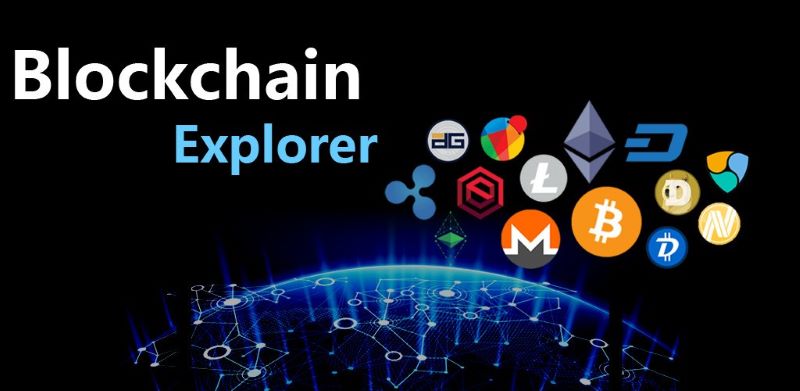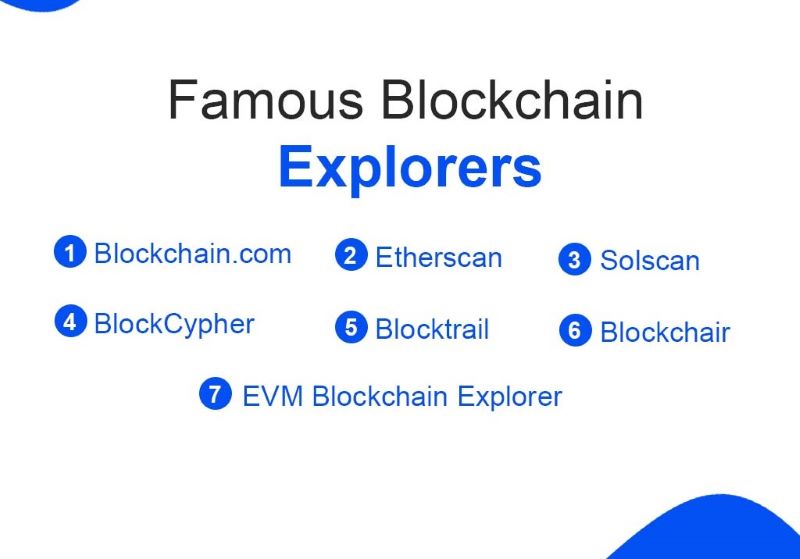Unveiling the Blockchain Explorer: Your Ultimate Guide to Crypto Navigation
Ever felt lost in the sea of digital currency? Navigating the crypto world can be like finding your way without a map. But fear not! This journey just got a whole lot easier. What is a Blockchain Explorer? Picture this: a powerhouse tool that lets you peer into the heart of public ledgers, making every bit of crypto’s complex web crystal clear. From tracking transactions to inspecting addresses, these explorers are not just helpers; they’re your trusty compass in the vast crypto landscape! Let’s dive in and discover the nuts and bolts of these navigational ninjas, and you’ll soon be charting your course like a seasoned crypto captain.
Understanding Blockchain Explorers: The Basics
What is a Blockchain Explorer?
Imagine a library that keeps all the secrets of crypto coins. A blockchain explorer is like that library. It lets you peek into every shelf and book, which means you can see every transaction ever made on the blockchain. Just like using a search engine, you type what you need to find. Instead of web pages, it finds transaction details for you.
Key Functions of a Blockchain Explorer
Now, let’s talk about what this cool tool does. A blockchain explorer digs into the digital currency world to show us lots of stuff.
Firstly, it’s a blockchain transaction tracker. Think of it like a GPS for crypto. It finds out where a coin started and where it’s going. It’s how you check if a crypto deal got done.
Also, it’s a kind of cryptocurrency ledger search party. It can look into the huge list of crypto dealings. If you need to find one particular transaction, that’s what this ledger search does.
And if you hear about a transaction hash, no worries. A transaction hash lookup is easy with a blockchain explorer. It’s like the ID for a deal in crypto land. You type this ID, and bam! You see all the details of that transaction.
Bitcoin address explorer helps you view all the deals tied to a Bitcoin address. It’s also a crypto transaction verification tool. It confirms if the crypto deal is the real deal. Yes or no, it tells you clearly.
It’s even a blockchain wallet lookup. Like a crypto detective, it uncovers all the coins hiding in a digital wallet.
The best part is, it’s all in the open, on a public ledger. So, a public ledger analysis? That’s another hat this explorer wears. It’s a digital currency inspector, a network block parser, and it uses blockchain query tools to fill you in on all the details.
Let’s not forget the block explorer features. It shows what’s happening on the Ethereum chain, like viewing a digital train track with ethereum chain viewer. Then there’s the recent block transactions teller, showing the newest crypto moves.
One more thing, it’s a mempool status checker. It’s like looking at a flight board at an airport, but for crypto. It shows which crypto’s waiting to go through.
Smart contract verifier? Check. It makes sure smart crypto contracts do what they promise.
If you’re into numbers, an address balance checker counts how many coins are at an address. It’s also great at blockchain navigation. So, finding your way through the crypto world gets easier.
And token movement tracker? It follows the path crypto takes, just like tracking a package you ordered online.
With chain analysis software, it splits open every block on the chain, showing you the crypto block dissect. Plus, with the help of a blockchain explorer API, computer programs can talk to the explorer and get this info in a snap.
In summary, a blockchain explorer is your best mate in the crypto playground. It helps you find every detail and ensures everything in the blockchain world is crystal clear.
Navigating the Interface: How to Use a Blockchain Explorer
Conducting a Transaction Hash Lookup
Ever wonder how to check where your crypto’s gone after you send it? You can use a blockchain explorer, which is like a search engine for cryptocurrency’s digital world. You can track any transaction with its transaction hash. Think of this hash as a unique ID for every trade. It’s a big mix of letters and numbers.
When you want to use a blockchain explorer to find out where your crypto is, you just need this hash. First, go to the explorer’s search bar and drop in the hash. Hit ‘search’. Boom! It shows you where your crypto’s traveled, from one digital wallet to another. You get to see if it’s still waiting (that’s called unconfirmed) or if it’s finished (that’s confirmed).
The idea’s simple. It’s like tracking a package you ordered online. But instead of seeing it go from the warehouse to your doorstep, you’re watching digital money move across the web. With one click, you know if your transaction’s safe and sound. If something seems off, it’s a heads up to dig deeper.
Exploring Bitcoin Address Histories
Now let’s talk about another cool use of blockchain explorers – checking a Bitcoin address’s past. Say you’ve got someone’s Bitcoin address. Maybe it’s yours, a friend’s, or a company you’re curious about. A blockchain explorer can show you every single transaction that’s happened at that address.
Start at the explorer’s homepage. There’ll usually be a box or a bar where you can type something in. This is where you enter the Bitcoin address you’re checking up on. Once you type it in and press the magic ‘search’ button, a history pops up. It shows all the Bitcoin that came in or out.
Think of it as peeking into a bank account’s activity, but it’s not hidden – it’s out there for everyone to see. It’s perfect when you want to make sure someone’s being straight with you about their Bitcoin. You can see how much they have or had. It shows you how busy the address is with incoming or outgoing Bitcoin.
And just like that, you’re in the know. You’re using a powerful tool to make sense of a complex web of transactions. It helps you trust the crypto world a bit more. It gives you a peek into the endless back and forth of digital currency.
Blockchain explorers are nifty tools that let you do some serious digital snooping, legally. They’re like detectives for your crypto, always ready to reveal the secrets of the blockchain. So the next time you’re wondering about a transaction or a Bitcoin address, remember, the blockchain explorer’s got your back.
Advanced Features of Blockchain Explorers
Decoding Raw Blockchain Data with Query Tools
Blockchain explorers are not just for viewing, they are powerhouse tools. With blockchain query tools, you can become a digital currency inspector. Think of query tools as magnifying glasses for crypto. They let you look at the fine print of the blockchain. Take a tricky transaction hash, for example. With the right tool, you can crack it open. You see where it’s been and where it’s going. Goodbye, confusion!
Query tools also help with your blockchain wallet lookup. Lost track of a transaction? A query tool digs deep and finds details. It’s like a treasure hunt. You search for hidden clues in a sea of numbers. It’s thrilling when you piece it all together.
Lastly, a blockchain explorer serves as a network block parser. This may sound tough. But it just means splitting the blockchain into bits you can understand. Like breaking down a big word into easier parts. This way, you get the full picture. Whatever you need, query tools and explorers are here to light the way.
Analyzing Smart Contract Interactions and Confirmations
Now, let’s jog over to the smart contract verifier. This is where you can watch smart contracts in action. If you’ve dipped your toes into Ethereum, you know these contracts are bits of code. They work without someone pulling the strings. But how do you check if they’re doing their job? Enter the blockchain explorer.
With it, you can look under the hood of these contracts. You can see when they kick into action. You get to confirm they follow the rules. But why should you care? Because these contracts move your tokens around! They’re crucial but can be as tricky as a puzzle. The explorer shows you every move, so you stay in control.
Explorers even let you peek at the recent block transactions. It’s like being at a train station, watching trains come and go. Each block is a train, carrying details about where crypto is moving. You get to see the cargo of these digital trains. This makes sure things are on track and safe.
And then there’s the mempool status checker. This is your waiting room for unconfirmed transactions. It’s like a pizza tracker but for crypto. You see transactions waiting to join a block. It tells you how busy the network is. A crowded mempool can mean a longer wait time. It helps you decide when to send your own crypto.
Block explorers unlock a world of info with clicks and searches. They make sure you’re not wandering in the dark in the crypto world. Use these tools to sharpen your blockchain navigation. With them, you’re set for an exciting adventure in the land of blockchain. Happy exploring!
Applying Blockchain Explorer Tools for Security and Analysis
Chain Analysis Software for Ledger Scrutiny
Let’s dive deep into the toolbox of every crypto detective: chain analysis software. This powerful aid tears through the blockchain’s complex layers. It peeks into every corner of a cryptocurrency ledger, follows the breadcrumbs of every transaction, and sniffs out what lies beneath.
Think of a blockchain transaction tracker as your personal digital bloodhound. It sniffs out any ledger activity tied to your search. Whether you’re a bitcoin address explorer or a crypto transaction verifier, this is your starting block.
Now, what’s a transaction hash lookup? It’s like using a barcode at the grocery store. You scan it and, poof, you see your item’s journey through the system. Blockchain works similarly. You scan the transaction hash, and you spot where your crypto raced off to.
The bitcoin address explorer goes hand-in-hand with the blockchain wallet lookup. You enter an address, and bam, you see all the coins that have popped in and out. It’s key for anyone digging into their own crypto movements or keeping tabs on others’.
Every public ledger analysis has one goal: ledger transparency. We’re talking about giving everyone the power to follow coins, tokens, and even the nitty-gritty details like block height information.
Monitoring Mempool Status for Unconfirmed Transactions
Ever sent a text and waited for it to say “delivered”? Monitoring the mempool status is kind of like that. You track unconfirmed transactions, which are just crypto texts that haven’t hit “delivered” on the other wallet’s screen.
Why check the mempool status checker? Congestion. Like morning traffic, sometimes the crypto highway gets jammed. A mempool status checker lets you peek at the backup. It shows you the queue of all the eager transactions, twiddling their digital thumbs, waiting their turn to join the blockchain.
Crypto block dissects dive into complete block data. What does this mean? Imagine slicing open a log and counting the rings. Here, you’re slicing into a block to see every transaction’s tale – how it began, where it ventured, and where it’s paused.
An address balance checker, on the other hand, focuses on the now. It answers “How much crypto is sitting in a wallet at this moment?” It’s a snapshot, a current balance check that brings you up to speed.
These tools, from crypto transaction verification to the blockchain indexer, lace up their detective boots for you. They make blockchain navigation less daunting. Instead of a wild jungle, it becomes a park with clear signs.
With a digital currency inspector on your side, you’re closer to uncovering the movements of the elusive crypto. The unconfirmed transactions pool becomes less murky, as each token’s story is told from departure to arrival, one block at a time.
In this post, we dug into what a blockchain explorer is and its main roles. You learned how to use it to check transaction hashes and Bitcoin address records. We also covered advanced tools for reading raw data and checking smart contracts.
Think of a blockchain explorer as a search engine for blockchain transactions. It’s your go-to for real-time data on what’s happening in the network. By using its features, you can boost your security when dealing with crypto and get sharp insights.
In the end, knowing how to use these explorers gives you the power to track and analyze blockchain actions like a pro. Stay curious, and keep exploring!
Q&A :
What is a Blockchain Explorer?
A Blockchain Explorer is an online tool that enables individuals to search and explore blocks, transactions, and addresses on a blockchain. It acts as a search engine for the blockchain, giving insights into transaction histories, wallet balances, and the flow of digital assets.
How does a Blockchain Explorer work?
A Blockchain Explorer works by indexing the data of a blockchain’s ledger, which is publicly available. It displays this information in a user-friendly format, allowing users to scrutinize individual blocks and transactions, inspect wallets, and verify the blockchain’s real-time status.
What are the common features of a Blockchain Explorer?
Common features of a Blockchain Explorer include the ability to view the most recent blocks and transactions, explore transaction histories, and search for specific addresses, blocks, or transactions by their unique identifiers. Advanced explorers may also provide analytics such as network hash rate, transaction growth, and currency statistics.
Can anyone use a Blockchain Explorer?
Yes, anyone with internet access can use a Blockchain Explorer. It’s designed to be a public tool for transparency and education, enabling users to learn more about blockchain transactions and the state of a particular network.
Why is a Blockchain Explorer important for cryptocurrency users?
A Blockchain Explorer is important for cryptocurrency users because it provides a transparent and trustless way to verify transactions. This is crucial for ensuring that funds have been transferred correctly, for tracking the history of tokens, and for confirming that the blockchain is operating as intended without the need for a trusted third party.




RELATED POSTS
Unmasking the Digital Deception: What is a Sybil Attack on Blockchain?
What is a Sybil attack...
Decentralized Learning Unchained: Navigating the Blockchain Education Revolution
"How do decentralized learning platforms...
Is Hashgraph Consensus the Future of Decentralized Technology?
Understanding Hashgraph: The Basics and...
What Is A Sybil Attack? Sybil Attacks Uncovered
What is a Sybil attack?...
Security of Smart Contracts: Ensuring Your Digital Dealings Are Ironclad!
Discover the crucial role of...
What is blockchain security?Is Your Digital Fortress Unbreachable?
What is blockchain security? Explore...
Blockchain Security Unveiled: Is Your Digital Fortress Impenetrable?
How secure is blockchain? Unpacking...
Blockchain Prediction Market: Navigate the Future, Bet on Outcomes
Blockchain Prediction Market: Explore Decentralized...
What is Metamask wallet and the secrets behind it
What is Metamask wallet and...
Mechanics Of Blockchain Technology: How It’s Transforming Tech
Learn the Mechanics of Blockchain...
AI Agents: Automation solutions for Web3 platforms
Artificial intelligence is ushering in...
Blockchain For KYC/AML: Streamlining Compliance For The Future
Blockchain for KYC/AML: Revolutionizing compliance...
Challenges of Blockchain in Education: Bridging the Equity Gap
Explore the challenges of using...
Emerging Consensus Mechanisms: Beyond PoW and PoS, What’s Next?
Emerging consensus mechanisms (alternatives to...
Unraveling the Mystery: What is a Block in Blockchain?
What is a block in...
Blockchain Security Breakdown: Why Trust is the Ultimate Currency
Discover the importance of trust...